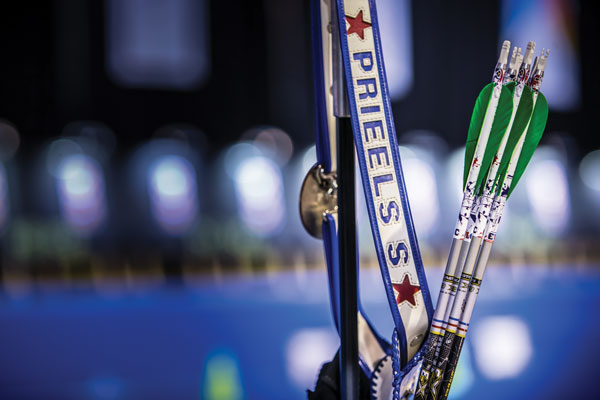Arrow building expert, Adrian Tippins of Custom Made Arrows answers your burning questions!
Q. What type of vanes should I be using?

There are so many types of vane available to us that it’s difficult to know what to choose
There is no right or wrong answer to this as all archers and all arrows are different. The primary consideration when choosing vanes is whether they are for indoor or outdoor arrows. Indoor arrows are usually wider in diameter and heavier in grains per inch. This means that there is physically more arrow to deal with. The job of a vane/fletching is stabilise and steer the arrow to the centre of the target. The bigger and longer the arrow, the bigger the vane needs to be. Indoor shooting requires super quick stabilisation as there isn’t a lot of time and distance to get the arrow clear of the bow and settled on the central line to the target. This is why most indoor arrows will often utilise large format vanes or feathers. It’s not unusual for the vanes to be three to four inches in length and with a high profile, as distance and wind aren’t considerations when shooting indoors. This is often accompanied by the fact that the arrows are often fletched helically with the addition of an offset. This creates a propeller or turbine effect, like a spin vane. Manufacturers are now providing large format spin vanes for indoor usage as they are ideal.
The main considerations for fletching choice when shooting outdoors are distance and wind resistance. The arrows are thin and therefore only require a small vane to provide the necessary amount of stabilsation. When considering distance we consider the amount of drag that vanes have. The higher the profile the more drag – which equals less distance. The profile of outdoor vanes is usually very slim. The vane length is usually between 1.75 and 2.25 inches, which is also true of spin vanes.
There are so many types of vane available to us that it’s difficult to know what to choose. A good place to start is understanding the different shapes. The normal shape of vane is called parabolic. This gives the fastest arrow exit speeds due to smooth airflow over the continuous aerodynamic curve. The shield cut vane affords a little more stabilisation than the parabolic as it disperses divergent air currents more effectively. Spin vanes are also now available with a small shield cut at the rear for greater stabilisation. Spin vanes offer slow exit speeds but terrific flight characteristics. Delta shaped vanes such as the Blazer offer the flattest trajectory for the longest amount of time due to maximising lift and are great for compound shooting.
Just lately there have been new additions to the market where manufacturers are offering low drag, low profile, longer vanes intended for compound use, where sight marks aren’t an issue but FOC and stabilising a heavy-pointed, slim arrow is. The ICE vane is a good example of this type and may well be found fletched helical with an offset for added effect.
This article originally appeared in the issue 121 of Bow International magazine. For more great content like this, subscribe today at our secure online store www.myfavouritemagazines.co.uk


What is the best alternative for marco mullen’s
Marco vanes m size 2.5